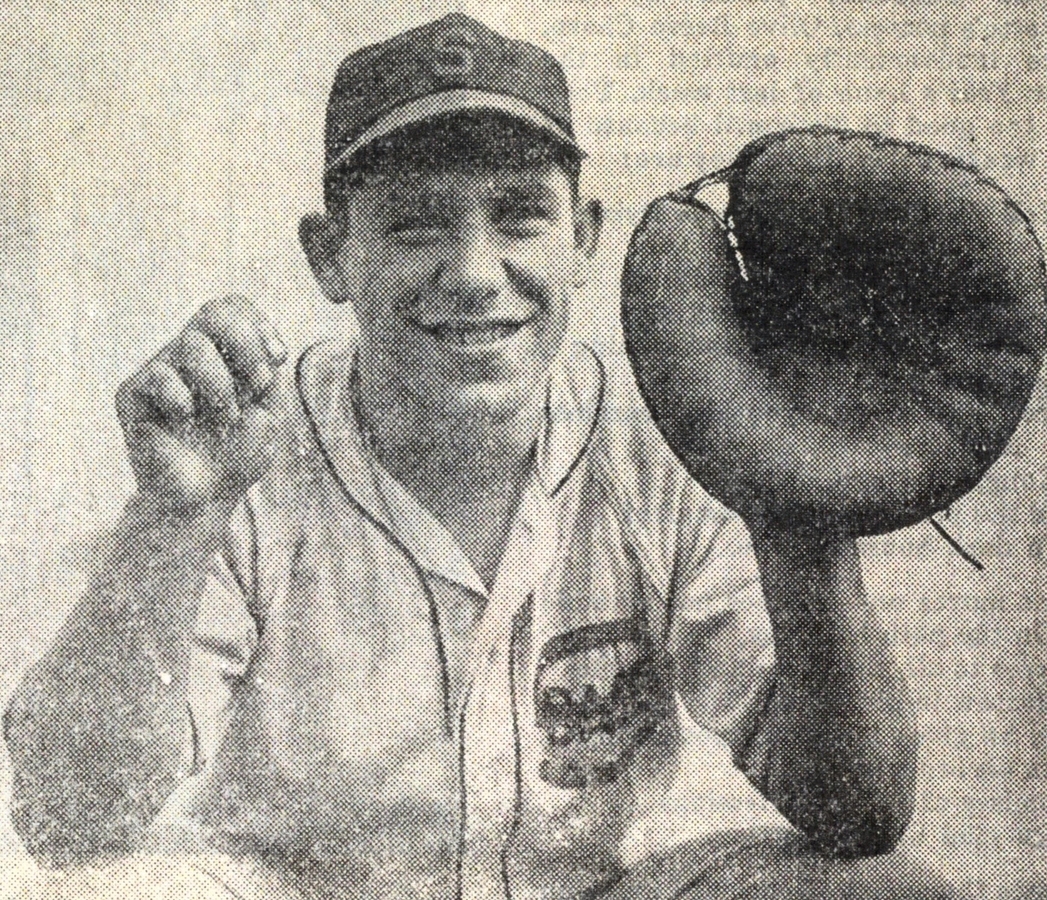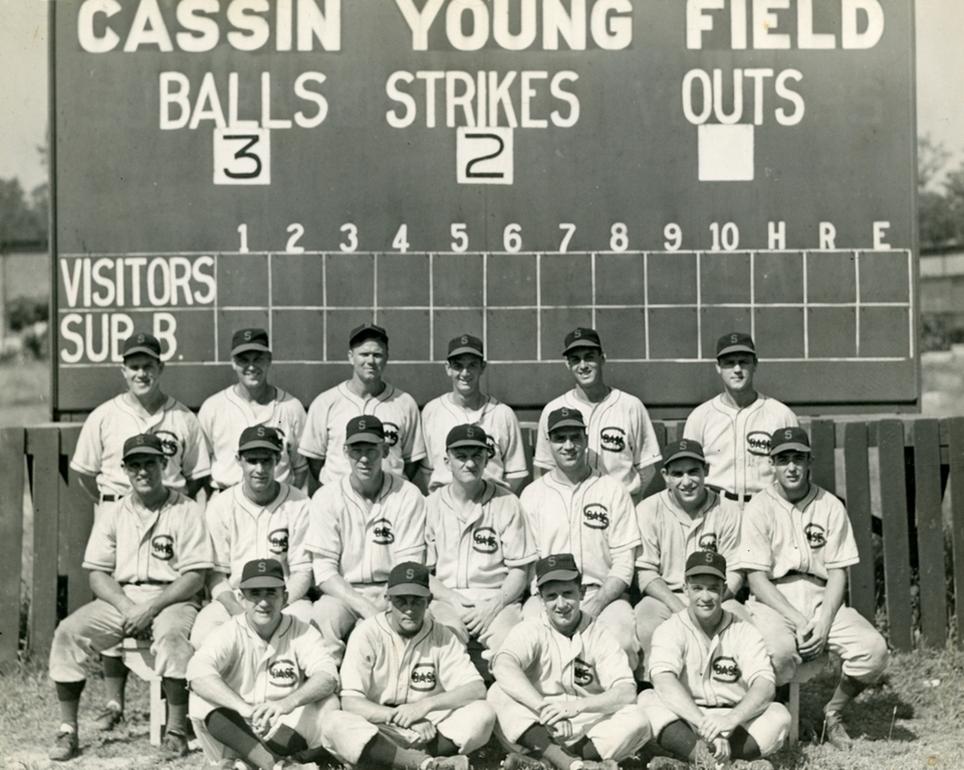
Yogi Berra was such an unknown in 1945 that he had to convince the manager he belonged on the sub base team. (U.S. Navy photo)
Editor's note: Information for this story came from the book "Yogi: The Autobiography of a Professional Baseball Player," the archives of The Day and several online baseball references.
Down 1-0 at Mercer Field in New London, the Naval Submarine Base baseball team sent up a pinch hitter with the tying run on second.
The squat, 19-year-old sailor, who had recently fought in the Normandy invasion, was named Larry Berra, but even at that early date, people were calling him Yogi.
In his first appearance with the team, he singled to right field and drove in the tying run. The date was May 9, 1945, the day after World War II ended in Europe.
Berra, who died Tuesday at age 90, was an unknown quantity that day. But his 1945 season at the sub base brought him to the attention of the baseball world.
By the end of the following year, he had joined the New York Yankees and begun his Hall of Fame career.
When he learned he had been transferred to the base in Groton, Berra was worried the Navy was going to put him on a submarine. But, as he wrote in his 1961 autobiography, that was not to be.
"When I found out that they had taken me seriously when I put down Sports and Recreation as the kind of duty I preferred, I could hardly believe it," he wrote.
His first assignment was to work at the base's theater as a maintenance man. He enjoyed the fringe benefit of seeing all the movies for free, but what he really wanted to do was play baseball.
Berra approached the manager of the base's team but had a hard time convincing him he was a ballplayer who had spent a year in the Yankees' farm system before joining the Navy.
"In my opinion those sailor suits don't add anything to anybody's appearance, but I think I looked worse in mine than most guys did," he wrote. But he managed to talk his way onto the team and reported for its first practice in April.
Because of the war, the team had more than its share of talent. There were several solid minor leaguers and a smattering of major leaguers as well.
Junior Thompson had pitched in two World Series for the Cincinnati Reds. Walt Masterson would later start the 1948 All-Star game for the American League.
Joe Glenn, the catcher, had been a backup for both the Yankees and Red Sox and held the curious distinction of having caught both Babe Ruth's last game as a pitcher and the only two innings ever pitched by Ted Williams.
When Berra proved he was for real with several successful pinch-hitting appearances, manager Jim Gleeson, himself a former major leaguer, made him the left fielder. He kept on hitting.
On May 31 at Mercer Field, Berra went 3 for 4 and homered twice off Randy Gumpert, who would later give up Mickey Mantle's first career home run.
On June 28, he went 4 for 5 as the sub base routed a team from the Quonset Naval Air Station in Rhode Island.
The team played in two leagues simultaneously.
The Southern New England Service League comprised teams from military bases in Connecticut and Rhode Island, including two Coast Guard teams from New London.
The Morgan League was a semipro circuit founded by a prominent New London family that included a shipyard owner and a mayor.
The five-team league was a small affair despite the wartime talent surplus. Early on, bad weather kept fans away and the league was in danger of folding for lack of gate receipts.
The Ockford Hose Co. team nearly dropped out because all of its bats had broken except one.
Berra was developing a reputation that would follow him to the majors: He would hit almost any pitch that was close enough to swing at.
Years later, Joe Rafferty, a New London police officer and longtime local umpire, recalled one at-bat.
With a runner taking a big lead off second, the opposing catcher, Gus Niarhos, called for a pitchout. Berra hit it for a double off the left-field fence.
Niarhos, who would later be Berra's Yankee teammate, turned to Rafferty and protested, "Hey, ump, that was a pitchout."
"Yeah," Rafferty responded, "but you didn't tell Yogi that."
The sub base team was a powerhouse against its Morgan and Service league rivals, but it also had a chance to show off against a higher order of talent.
In 1945, the region's baseball fans were lucky enough to see eight exhibition games between local clubs and visiting major league teams. The sub base played four of those games and won three, all convincingly.
They beat the Boston Braves, 8-2, the Washington Senators, 14-9, and the New York Giants, 8-3. Only the lowly Philadelphia Phillies were able to hold them down.
In those four games, Berra was a combined 5 for 16 for a .313 average. The game against the Giants was the one that got him noticed.
Mel Ott, the Giants' manager, used three of his regular pitchers and watched Berra get two hits off them and launch another pitch 400 feet to deep centerfield.
Afterward, he talked to Gleeson, Berra's manager, who told him Berra belonged to the Yankees.
"But," Gleeson told Berra later, "he still was interested. I wouldn't be surprised if you heard from him again."
In his autobiography, Berra recounted what he heard happened next.
Ott went to Horace Stoneham, who owned the Giants, and recommended that he try to acquire Berra. Stoneham approached Larry MacPhail, the Yankees' president, and offered $50,000.
The amount got MacPhail's attention, so after turning down the offer, he summoned Berra to New York to find out why the Giants thought he was worth so much.
The interview went well, Berra wrote, and MacPhail told him he would be assigned to Newark, the Yankees' top farm club, as soon as he got out of the Navy.
"I went back to New London feeling pretty good," he wrote.
As the summer went on, war still raged in the Pacific, while captured German U-boats arrived in Groton.

The 1945 Naval Submarine Base baseball team, seen at Cassin Young Field on the base, was a powerhouse of the local Morgan League and a wartime service league. Yogi Berra, second from right in the middle row, then a 19-year-old unknown, was the team´s best hitter. Manager Jim Gleeson is fourth from right in the middle row. (U.S. Navy photo)
Berra had taken over behind the plate after one catcher was transferred and another broke an ankle.
He was making extra cash playing for a semipro team called the West Haven Sailors on weekends.
In August, the sub base was closing in on the pennant in both leagues when the U.S. dropped the atomic bombs on Japan.
When the surrender was announced, the team was one win away from clinching each league.
But with the war's end, three-quarters of the base was granted liberty, and the games were postponed.
Within a week, both titles were locked up. The team went on to sweep a best-of-three postseason series from the Coast Guard Bears, as Berra homered and drove in two runs in the deciding game.
He won two batting championships, hitting .429 in the Service League and .445 in the Morgan League. Player-manager Gleeson came in second at .431.
When Berra became manager of the Yankees in 1964, he would hire Gleeson as his first-base coach.
At the end of 1945, when The Day conducted its annual sports poll, the result was announced in a banner headline: "Larry 'Yogi' Berra, Sub Base Batting Star, New London's No. 1 Athlete."
The next spring, still awaiting discharge, Berra was in the opening day lineup against the Merchant Marine Academy.
Two weeks later, he was out of the Navy and on his way to Newark. By then a legitimate prospect, he wouldn't be in the minor leagues for long.
Before he left, local fans got to see Berra's potent bat one last time. In a 13-0 rout of the Merchant Marines, he went 2 for 4 with a double and an RBI.
They were his first two hits of the 1946 season. The last two would come five months later, at Shibe Park in Philadelphia, for the Yankees.

